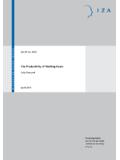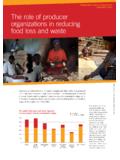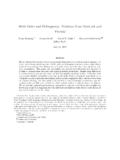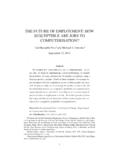Transcription of ISSN 0254-4725 FAO Probiotics in food FOOD AND …
1 ISSN 0254-4725 . Probiotics in food FAO. FOOD AND. NUTRITION. health and nutritional properties PAPER. and guidelines for evaluation 85. This paper includes joint FAO and WHO work to evaluate the latest information and scientific evidence available on the functional and safety aspects of food Probiotics , as well as the methodology to assess such aspects, by bringing together worldwide scientific experts in the field. It includes the reports of the expert consultation and of the working group. These reports provide scientific advice in relation to the safety assessment of Probiotics , general guidance for their evaluation and on specific questions in relation to their pathogenicity, toxigenicity, allergenicity, as well as to their functional and nutritional properties .
2 The guidelines for the evaluation of Probiotics in foods were developed as part of this joint effort, providing criteria and methodology to assess the efficacy and the safety of these products ISBN 92-5-105513-0 ISSN 0254-4725 . 9 789251 055137. TC/M/A0512E/1 2 TQDKQVKEU KP HQQF (#1. (11& #0&. 0764+6+10. *GCNVJ CPF PWVTKVKQPCN RTQRGTVKGU 2#2'4. CPF IWKFGNKPGU HQT GXCNWCVKQP.. 4 GRQTV QH C ,QKPV (#1 9*1 'ZRGTV %QPUWNVCVKQP . QP 'XCNWCVKQP QH *GCNVJ CPF 0 WVTKVKQPCN 2 TQRGTVKGU . QH 2 TQDKQVKEU KP (QQF KPENWFKPI 2 QYFGT /KNM YKVJ .KXG ..CEVKE #EKF $CEVGTKC. %QTFQDC #TIGPVKPC 1 EVQDGT . 4 GRQTV QH C ,QKPV (#1 9*1 9 QTMKPI )TQWR QP &TCHVKPI.))))
3 WKFGNKPGU HQT VJG 'XCNWCVKQP QH 2 TQDKQVKEU KP (QQF..QPFQP 1 PVCTKQ %CPCFC #RTKN /C[ . *'#.6* 14)#0+<#6+10 . (11& #0& #)4+% ' 14)#0+<#6+10 1( 6*' 70+6'& 0#6+105. 4 QOG . 6JG QRKPKQPU GZRTGUUGF KP VJGUG TGRQTVU CTG VJQUG QH VJG . RCTVKEKRCPVU CPF FQ PQV KORN[ CP[ QRKPKQP QP VJG RCTV QH (#1 . CPF 9*1 . 6JG FGUKIPCVKQPU GORNQ[GF CPF VJG RTGUGPVCVKQP QH OCVGTKCN . KP VJKU KPHQTOCVKQP RTQFWEV FQ PQV KORN[ VJG GZRTGUUKQP QH CP[ . QRKPKQP YJCVUQGXGT QP VJG RCTV QH VJG (QQF CPF #ITKEWNVWTG . 1 TICPK\CVKQP QH VJG 7 PKVGF 0 CVKQPU EQPEGTPKPI VJG NGICN QT . FGXGNQROGPV UVCVWU QH CP[ EQWPVT[ VGTTKVQT[ EKV[ QT CTGC QT QH . KVU CWVJQTKVKGU QT EQPEGTPKPI VJG FGNKOKVCVKQP QH KVU HTQPVKGTU QT.))]]]]]]]]]]
4 DQWPFCTKGU . +5$0 . #NN TKIJVU TGUGTXGF 4 GRTQFWEVKQP CPF FKUUGOKPCVKQP QH OCVGTKCN KP VJKU . KPHQTOCVKQP RTQFWEV HQT GFWECVKQPCN QT QVJGT PQP EQOOGTEKCN RWTRQUGU CTG . CWVJQTK\GF YKVJQWV CP[ RTKQT YTKVVGP RGTOKUUKQP HTQO VJG EQR[TKIJV JQNFGTU . RTQXKFGF VJG UQWTEG KU HWNN[ CEMPQYNGFIGF 4 GRTQFWEVKQP QH OCVGTKCN KP VJKU . KPHQTOCVKQP RTQFWEV HQT TGUCNG QT QVJGT EQOOGTEKCN RWTRQUGU KU RTQJKDKVGF . YKVJQWV YTKVVGP RGTOKUUKQP QH VJG EQR[TKIJV JQNFGTU #RRNKECVKQPU HQT UWEJ . RGTOKUUKQP UJQWNF DG CFFTGUUGF VQ VJG %JKGH 2 WDNKUJKPI /CPCIGOGPV . 5 GTXKEG +PHQTOCVKQP &KXKUKQP (#1 8 KCNG FGNNG 6 GTOG FK %CTCECNNC . 4 QOG +VCN[ QT D[ G OCKN VQ EQR[TKIJV"HCQ QTI.)]]]]]]]
5 L (#1 CPF 9*1 .. Foreword The beneficial effects of probiotic foods on human health and nutrition are increasingly recognized by health professionals. Recent scientific work on the properties and functionality of living micro-organisms in food have suggested that Probiotics play an important role in immunological, digestive and respiratory functions, and that they could have a significant effect on the alleviation of infectious diseases in children and other high-risk groups. In parallel, the number and type of probiotic foods and drinks that are available to consumers, and marketed as having health benefits, has increased considerably.)
6 In view of this growing popularity of probiotic foods, and the lack of international consensus on the methodology to assess their efficacy and the safety, FAO and WHO. initiated work to examine the scientific evidence on the functional and safety aspects of Probiotics in food. In particular, an expert consultation on the health and nutritional properties of powder milk with live lactic acid bacteria was convened by FAO and WHO. in Cordoba, Argentina in 2001, and an expert working group organized in 2002 to develop guidelines for the evaluation of Probiotics in food. The FAO/WHO consultation in 2001 brought together international scientific experts to evaluate available information on the functional and safety aspects of Probiotics in powder milk.
7 The consultation examined available scientific information on the dietary impact of Probiotics , evaluated their properties , benefits, safety and nutritional features, and considered their potential adverse effects, taking into consideration work done by national authorities, FAO, WHO and other international organizations and relevant global fora. It reviewed the scientific basis for health claims linked to probiotic foods, considered regulatory needs and discussed strategies for the safety and nutritional assessment of Probiotics , taking into account public concerns and food safety evaluation findings. The consultation generated a number of recommendations for further research, as well as priorities for the evaluation of safety and nutritional aspects of Probiotics and regulatory requirements.
8 In follow-up to this consultation, FAO and WHO convened an expert working group to develop Guidelines for the Evaluation of Probiotics in Food. The resulting Guidelines provide a methodology for use in the evaluation of Probiotics , and define the criteria and specific levels of scientific evidence needed to make health claims for probiotic foods. By supporting the development of scientific knowledge on the functional and safety aspects of Probiotics , FAO and WHO hope to enhance the overall safety and quality of food for consumers. In particular, it is hoped that the outputs of the FAO/WHO expert consultation and working group on Probiotics will be used as a science-based assessment process for managerial decisions on Probiotics , and that the Guidelines for the Evaluation of Probiotics in Food will provide a practical model to scientifically evaluate Probiotics and be adopted by industry.
9 It is also expected that these outputs will be useful for national work on health and nutrition claims, and as a scientific assessment of a novel food. health and Nutrition properties of Probiotics in Food including Powder Milk with Live Lactic Acid Bacteria Report of a Joint FAO/WHO Expert Consultation on Evaluation of health and nutritional properties of Probiotics in Food including Powder Milk with Live Lactic Acid Bacteria Cordoba, Argentina 1-4 October 2001. The opinions expressed in this report are those of the participants of the Working Group and do not imply any opinion on the part of FAO and WHO. Joint FAO/WHO Expert Consultation on Evaluation of health and nutritional properties of Probiotics in Food including Powder Milk with Live Lactic Acid Bacteria, 1-4 October 2001.
10 CONTENTS. 1. 1. 2. 1. 3. 1. 4. History of 2. 5. Guidelines for the Assessment of Probiotic 4. Selection of probiotic strains for human 4. Classification and identification of individual 5. Defining and measuring the health benefits of 5. 6. Testing methods for establishing health benefits conferred by probiotic 12. 7. Safety 13. Antimicrobial resistance profiles of 13. Safety of Probiotics in 14. 8. Probiotic product specifications, quality assurance and regulatory issues .. 15. Regulatory issues .. 15. Appropriate labeling .. 16. Manufacturing and handling 16. 17. 9. Post market 17. 10. 18. 11. 18. 12. List of 20. 13. 21.















![arXiv:1705.08807v3 [cs.AI] 3 May 2018](/cache/preview/f/8/1/5/0/b/9/c/thumb-f8150b9c860139155c1b7712612d950a.jpg)